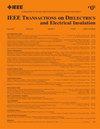Simulation and Modeling of Prompt Electrical Tree Formation During Dielectric Breakdown in Space-Charged Dielectrics
IF 3.1
3区 工程技术
Q2 ENGINEERING, ELECTRICAL & ELECTRONIC
IEEE Transactions on Dielectrics and Electrical Insulation
Pub Date : 2025-08-07
DOI:10.1109/TDEI.2025.3550102
引用次数: 0
Abstract
Electrical treeing is a principal degradation mechanism in polymeric dielectric material bombarded with charged particles. Such bombardment occurs when the material is exposed to space radiation environments. Treeing occurs during the rapid evacuation of charges that are embedded in the material and often culminates in catastrophic equipment failure. This article outlines the development and validation of a novel simulation model to depict electrical tree discharge within a dielectric polymethyl methacrylate block, but this model provides predictive power for any similar dielectric material. Dielectric materials have advantageous insulating properties and are crucial for aerospace applications, but the possibility of discharge failure due to electrical treeing poses a substantial risk to in-flight equipment. It jeopardizes expensive equipment, mission objectives, and the safety of any on-board crew. This article utilizes insights from novel imaging techniques that reveal characteristics of electrical treeing, such as the speed and development of the erosion wavefront and the speed at which the detrapped charge evacuates the material. A geometric model and an RLC model are proposed to model this observed behavior, and a stochastic model for the development of the Lichtenberg figure (LF) that incorporates these insights is presented and compared with the experimental results, validating the model with an空间带电介质中介电击穿时迅速电树形成的仿真与建模
电树是带电粒子轰击下聚合物介质材料的主要降解机制。当材料暴露在空间辐射环境中时,就会发生这种轰击。在快速疏散埋在材料中的电荷时发生树形,并常常导致灾难性的设备故障。本文概述了一种新的模拟模型的开发和验证,以描述电介质聚甲基丙烯酸甲酯块内的电流树放电,但该模型提供了任何类似的电介质材料的预测能力。介电材料具有优越的绝缘性能,对航空航天应用至关重要,但由于电气树导致放电故障的可能性对飞行设备构成了重大风险。它危及昂贵的设备、任务目标和任何机上人员的安全。本文利用了新的成像技术的见解,揭示了电树的特征,如侵蚀波前的速度和发展,以及去除的电荷从材料中撤离的速度。提出了一个几何模型和一个RLC模型来模拟这种观察到的行为,并提出了一个用于发展利希滕贝格图(LF)的随机模型,该模型包含了这些见解,并与实验结果进行了比较,验证了该模型的${R}^{{2}}$值为0.93,并突出了未来发展的领域。
本文章由计算机程序翻译,如有差异,请以英文原文为准。
求助全文
约1分钟内获得全文
求助全文
来源期刊
CiteScore
6.00
自引率
22.60%
发文量
309
审稿时长
5.2 months
期刊介绍:
Topics that are concerned with dielectric phenomena and measurements, with development and characterization of gaseous, vacuum, liquid and solid electrical insulating materials and systems; and with utilization of these materials in circuits and systems under condition of use.

 求助内容:
求助内容: 应助结果提醒方式:
应助结果提醒方式:


